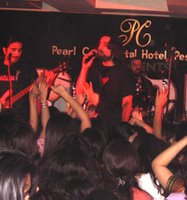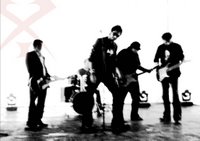Above, far and beyond
How many times have you wished that you could just ray-gun someone of out your sight? Or while stuck in the infamous Karachi traffic, wished there were beaming stations from where all you had to do was say “energise” and you would then conveniently be transported (beamed) to the destination of your choice within seconds? From where did such ideas enter into our heads anyway?
Science fiction or Sci-Fi as it is popularly known, has been a part of literature ever since an over imaginative person discovered he or she could write. It included things the writer thought was to come and create a magical world without any magic spells, potions and unicorns. Instead, these objects would be replaced by man-made gadgets and inventions that were capable of performing wonders. Science fiction writers wrote based on what they thought the world would be like several decades or centuries after the time-period that they were in.
Literature categorised as science fiction is described as those in which the author creates an illusionary world involving hypothetical, physical, biological, technological, philosophical, historical or cultural constraints. This is done for the purpose of relating or exploring specific aspects of human behaviour, life or the universe under these new, contrived conditions. These writers reflect their awe for science and their hopes of what scientific research could yield. However, it also displayed their fears in cases where scientific research would end up reaching harmful conclusions, the consequences of which would have to be suffered by all mankind, animal-kind and earth-kind. A quick read will make it clear that Sci-Fi writers are more prone to write about the future they hope will not happen rather then that which they would want to.
One thing needs to be taken into consideration however, and that is that predictions made by science fiction writers are deeply influenced by those scientific possibilities that are mutually understood by people in that era. Also there is a considerable portion of fantasy in science fiction and many science fiction writers have also written what is known as fantasy literature.
Decades after popular science fiction writers forecasted the future of mankind, one wonders how accurate their predictions were. Now that we are in the ‘future’ that they used to write about, how has the advancement or deterioration of mankind measured up to the imagination of these Sci-Fi writers?
Some of the predictions that did end up coming true are from the popular classic book, Twenty Thousand Leagues Under The Sea by Jules Verne. He is considered to be the first to ever merit being catagorised as a science fiction writer. Most of his books including his first best-seller Five Weeks In A Balloon, From the Earth to the Moon and two other books that later got adapted to screen-plays, The Mysterious Island and the famous classic, Twenty Thousand Leagues Under The Sea, deal with voyages and exploration where his characters are constantly marvelling at the new scientific discoveries that they end up making.
to screen-plays, The Mysterious Island and the famous classic, Twenty Thousand Leagues Under The Sea, deal with voyages and exploration where his characters are constantly marvelling at the new scientific discoveries that they end up making.
In Twenty Thousand Leagues Under The Sea, Jules Verne had predicted that there would be self-propelled submarines that would be capable of diving and travelling underwater at very high speeds. He also predicted in the same novel that electronic watches that would be far more accurate then analog clocks and that electric generators would be used to propel very large sized engines. Furthermore, he predicted that underwater aqualungs (portable cylinders with compressed oxygen in them) coupled with adequate wetsuits would enable deep sea divers to remain underwater and work on the ocean floor for longer periods of time. He also spoke about how submarine warfare would render ships travelling on the surface of the water absolutely helpless against them.
Another popular science fiction writer, H.G. Wells has written books that set the background standard for other science fiction writers to work on. He has written one screen play, Things To Come, in which he tried to depict, in detail, the horrifying implications of World War II. Out of all his books, two of the most well-known were adapted for the big screen quite successfully. First one being The Time Machine, in which he showed time-travel through the ages and the result of the human race. The other was War of the Worlds in which he depicts the horrors of an alien invasion on earth.
In his book, Things To Come, which was published in 1933, H.G. Wells ended up with a few successful predictions including that World War II would start in 1940 and would involve all of the major countries in the world as well as air-raids and dog-fights between enemy aircrafts. He also predicted the implementation of gas warfare.
Amongst his non-war related predictions from the same book, to have been invented by the year 2054, was the introduction of air-conditioning, video tape recording and commercial television and televised broadcasts reaching almost all parts of the world. All of the inventions mentioned above have been introduced to mankind well before 2054.
A prediction that did not end up being successful was the reconstruction of the world till it reaches utopia in the year 2054. Hopefully by then, ‘enlightened’ human beings would have gotten rid of all kinds of instruments that lead to death and destruction. One of the predictions that yet to come true is that citizens will be wearing personal communication devices on their sleeves at all times. This is oddly reminiscent of the use to cellphones nowadays which most people have and keep on their self almost all the time.
In his book, When the Sleeper Awakes, H. G. Wells predicts the invention and use of all-purpose liquid food, portable television sets, use of automatic doors, mechanised agriculture and ‘light globes that change night into day’ (light bulbs). Those predictions that sound like fun, but yet to be realised, are an automatic clothes-making machine, special ‘pleasure cities to placate the masses’ (Dubai, perhaps?) and moving conveyor roadways. He also predicted that most of Earth’s population would be concentrated in great super-cities.
Brian Aldiss, another science fiction writer who wrote primarily about space travel and nuclear technology, in his book, Who Can Replace A Man, predicts space flight to Mars and sound being used as a weapon.
a weapon.
His predictions still to see daylight is the introduction of robots to serve and support human communities and robot wars after mankind becomes extinct. He also predicted anti-gravity to have found its way to Earth by the year 2500 A.D.
First Published:
Spider
October 2006





























